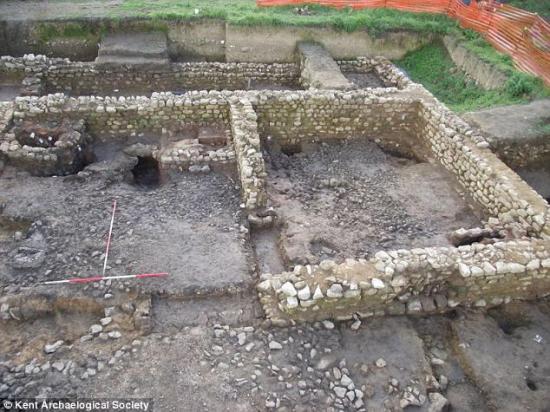PART. 2
Part of the tablet's significance also lies in the fact the Romans were the first literate inhabitants of Britain, making it and other similar items among the earliest written records of British life.
'If this is a curse tablet, which it seems to be, it is presumably a product of its local community - so it is a reasonable guess that the persons named on it lived there,' Dr Tomlin said.
Dr Tomlin explained the presence of Celtic names on the scroll. 'They are Celtic in etymology (but) they have Latin case-endings,' he said.
'So far as we can judge there was a mix of Roman and Celtic names in the name-stock of Roman Britain. Just as in modern Britain, it would be risky to deduce national differences from names alone.'
The Kent Archaeological Society is paying the Sittingbourne-based Conservation Science Investigations (CSI) to conserve the tablet and continue research.
The group hopes the public will be able to visit CSI's offices to watch some of the work as it is underway. It may be possible to put the scroll on public display at the end of this year.
The East Farleigh site has been slowly excavated since 2005. Following a geophysical survey using a resistivity meter, the foundations of the walls of three rooms and a corridor were unearthed.
Pits below the rooms contained painted wall plaster and tiles from an underfloor heating system. with archaeologists discovering relics including painted wall plaster and an underfloor heating system.

The East Farleigh site: Pits below the rooms contained painted wall plaster and tiles from an underfloor heating system
Since 2007 several more buildings have been located, parts of which had been destroyed during the construction of a hop-garden for Courage Brewery in 1939.
Discoveries have included the remains of a store room, two bread ovens, a cooking fire, a quern stone for grinding corn and a wall rendered, painted and decorated to imitate marble cladding.
In what had been a kitchen there were pottery vessels with flint grits for grinding food and spices, many broken cooking pots manufactured locally, and better quality pots from Hampshire and Oxfordshire.

Dig: Discoveries have included the remains of a store room, two bread ovens, a cooking fire, a quern stone for grinding corn and a wall rendered, painted and decorated to imitate marble cladding
Scattered on the kitchen floor were broken copper bracelets and a ring, decorated with snakes (‘lucky charms’ for good health).
A piece of Whitby jet jewellery, part of a greenstone cosmetic mixing pallet, a bunch of keys, a bronze child’s bracelet, a gaming counter and bone pins have been also been excavated.
A hoard of 153 mid-fourth century copper coins, dumped on a floor, has been donated to Maidstone Museum.
ROMAN 'BLACK MAGIC' HOT SPOT
A curse tablet or binding spell (defixio in Latin) is a type of curse found throughout the Graeco-Roman world, in which someone would ask the gods to do harm to others.
They have been throughout Europe with more than 200 found in Britain alone - particularly around the South West, which has been one of the major centres for finds of the curses.
The largest collection of such tablets - around 130 - was found in the thermal spring in Bath - known to the Romans as Aquae Sulis - and are on display in the Roman Baths Museum.
The second-largest collection of around 80 is from the Roman temple to Mercury at Uley, with some of those displayed in the British Museum.
The texts were typically scratched on very thin sheets of lead in tiny letters, before being rolled or folded and pierced with nails.
The bound tablets were then usually placed beneath the ground in graves, tombs or underground sanctuaries, or otherwise thrown into wells or pools, or nailed to the walls of temples.
Not all tablets were intended to bring harm to those named. Some were used for love spells, which would be placed in the home of the intended recipient.